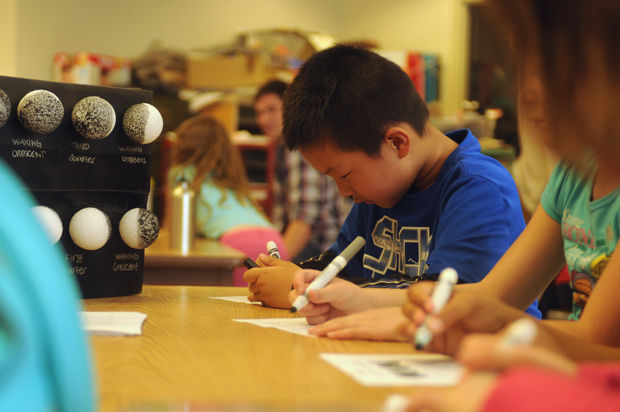Education students gain professional experience, give back
April 1, 2015
Franklin Elementary School students dug their fingers into the mock quicksand mixture of cornstarch and water, and watched as the material transformed from a solid to a liquid.
This was just one of the science experiments students from Washington State University’s College of Education created and presented to Pullman elementary schools through the YMCA program.
On Monday, a group of WSU elementary education students visited Franklin Elementary. They set up tables, each equipped with a different science experiment.
The elementary students were free to visit the different tables to learn more about various scientific topics, such as physics and chemistry.
“They just did their science fair last week so some of these kids still have science on the mind,” said Kaylan Petrie, WSU teaching assistant for the College of Education’s science methods class.
Each station provided a chance for the elementary students to become physically involved through a multitude of different activities.
“The more one-on-one action with the kids is great,” said Leah Watts, program coordinator for the YMCA at Franklin Elementary School.
Michaela George and Anna Summers, juniors studying Elementary Education, planned their curriculum based on the science behind quicksand. At the table there was pseudo quicksand made of cornstarch and water for the children to play with.
“We thought back to when we were in elementary school and what we thought was cool,” George said.
Other curriculums included learning about the physics of a lever, the phases of the moon, and the chemistry behind cleaning copper pennies.
Along with learning about science from the WSU students, the children were also able to practice the YMCA’s core values of caring, honesty, respect, and responsibility.
“This is a great time to reinforce those values,” Watts said.
Between all three of the elementary schools, the WSU students taught 50 – 60 first-, second- and third-graders.
College of Education students visit elementary students throughout the fall and spring semesters and also during summer programs.
“We have many opportunities for people who want to become teachers to come in and volunteer,” Watts said.
In just one to two years, these elementary education students will be getting their teaching degree, Petrie said.
By teaching the science methods classes, elementary education students are experiencing first-hand what they will encounter in a professional setting, Petrie said.
“There’s less pressure because they will at least have some experience,” she said.






















